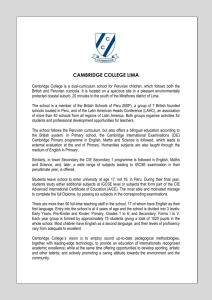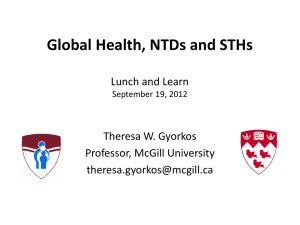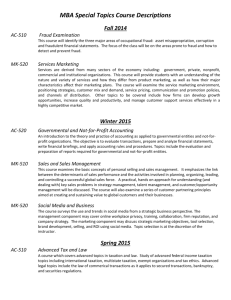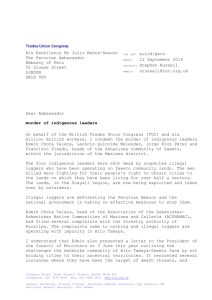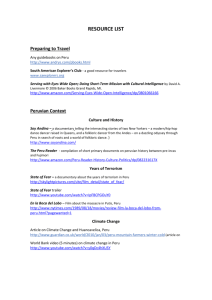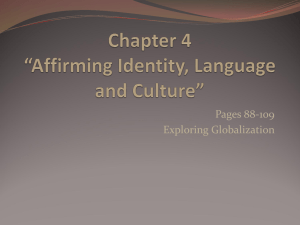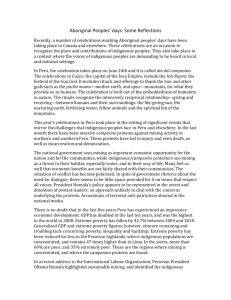Document
advertisement
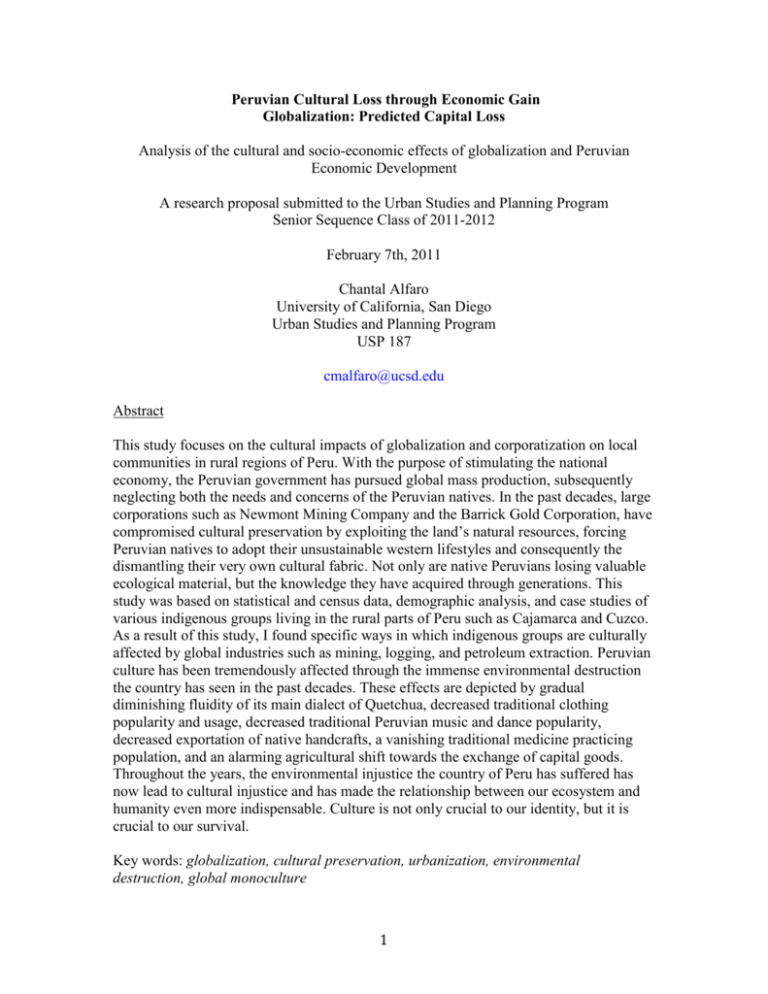
Peruvian Cultural Loss through Economic Gain Globalization: Predicted Capital Loss Analysis of the cultural and socio-economic effects of globalization and Peruvian Economic Development A research proposal submitted to the Urban Studies and Planning Program Senior Sequence Class of 2011-2012 February 7th, 2011 Chantal Alfaro University of California, San Diego Urban Studies and Planning Program USP 187 cmalfaro@ucsd.edu Abstract This study focuses on the cultural impacts of globalization and corporatization on local communities in rural regions of Peru. With the purpose of stimulating the national economy, the Peruvian government has pursued global mass production, subsequently neglecting both the needs and concerns of the Peruvian natives. In the past decades, large corporations such as Newmont Mining Company and the Barrick Gold Corporation, have compromised cultural preservation by exploiting the land’s natural resources, forcing Peruvian natives to adopt their unsustainable western lifestyles and consequently the dismantling their very own cultural fabric. Not only are native Peruvians losing valuable ecological material, but the knowledge they have acquired through generations. This study was based on statistical and census data, demographic analysis, and case studies of various indigenous groups living in the rural parts of Peru such as Cajamarca and Cuzco. As a result of this study, I found specific ways in which indigenous groups are culturally affected by global industries such as mining, logging, and petroleum extraction. Peruvian culture has been tremendously affected through the immense environmental destruction the country has seen in the past decades. These effects are depicted by gradual diminishing fluidity of its main dialect of Quetchua, decreased traditional clothing popularity and usage, decreased traditional Peruvian music and dance popularity, decreased exportation of native handcrafts, a vanishing traditional medicine practicing population, and an alarming agricultural shift towards the exchange of capital goods. Throughout the years, the environmental injustice the country of Peru has suffered has now lead to cultural injustice and has made the relationship between our ecosystem and humanity even more indispensable. Culture is not only crucial to our identity, but it is crucial to our survival. Key words: globalization, cultural preservation, urbanization, environmental destruction, global monoculture 1 Introduction “May our good customs and laws be retained that among us have existed and exist, suitable for our government and justice, and other things that we are accustomed to having in the time of our fidelity”; a quote stated by Jose Gabriel Tupac Amaru in 1562 when leading an indigenous rights movement against Spanish invaders in Cuzco. Tupac Amaru is Peru’s most celebrated national hero, symbolizing courage, strength, and wisdom. In this quote, Amaru pleads for the remembrance and continuation of the community’s cultural beliefs, which the Spanish conquistadors were threatening. With the regressing world economy, and subsequently the devaluation of the American dollar, countries have relied more and more on their environment to make a profit. Profitable but environmentally degrading practices such as mining, logging, and petroleum extraction constitute the main Peruvian export activities today. In recent years, the Peruvian economy has found itself dominated by global trends such as export and capital trade, which takes full advantage of its environmental abundance. Surely, the exhaustion of Peru’s resources and the country’s environmental damage is irreversible. In an attempt to make its mark as an economic power, the developing country of Peru continues to exploit their land and strip the soil of non-renewable materials. In past years, not only has the Peruvian biodiversity and environment been affected, but the Peruvian culture has also been exhausted along with it. 2 Since Fujimori’s rise to power in 1990, a number of bills have been passed in order to stimulate the economy; including Law 653, which promotes foreign investment in the agricultural sector; and the 1995 Land Law, which enabled collective groups to divide and sell land held in common (Kuramoto, 2009). This has caused a revalorization of land-use resources and shifted the government’s priorities while accelerating the privatization of land and has facilitated mining companies to buy them without the consent of the residents (Ossio, 1998). As a result, land in these indigenous rural areas has become scarce and impotent, forcing families out of the region and into cities at lower elevations. At lower elevations, however, practices such as horticulture and livestock production become very difficult. Rural areas are heavily dependent on agriculture and the herding of animals such as sheep, llamas, alpacas, and vicunas, which require high altitude; however, the soil at lower altitudes is not as fertile and is unfamiliar to them (Madeley, 1999). As a result of this project I successfully explained the negative cultural effects that globalization has had not only on the environment, but on the culture of rural Andean communities of Peruvian Sierra. These effects include the diminishing fluidity of the Peruvian dialect Quetchua, the loss of traditional agricultural practices, the diminishing of folklore traditions such as weaving, ceramics, and artesian metalwork; the loss of food and medicinal recipes, and with this the change of sustenance practices and therefore a shift in the Peruvian culture and lifestyle. The significance of my project targeted the ways in which indigenous Peruvian groups have had to culturally adapt to the practices of globalization, or have had to give up their inherited homelands for a westernized living space. Although my study was 3 extensive, there is a limited amount of data available when searching for specific case studies on the detrimental cultural effects of the globalization and mass production in Peru. Analyzing these relationships will help our understanding of how Peruvian culture is affected. Literature Review Peru is celebrated not only for its exceptional biological assortment, but also for its cultural diversity. Peru is distinctly recognized as having one of the most diverse native cuisines and is ranked the third most biodiverse country in the world (Dore, 1998). Globalization has brought both positive and negative impacts to the Peruvian nation-state. Globalization has provided economic development in the urban parts of the country by improving its infrastructure and providing a middle class. Globalization has allowed Peru to take full advantage of its natural resources such as precious metals, natural gas, petroleum, rainforests, an exceptional array of flora and fauna, and its unique climate that thus far has allowed its renown vegetation to grow and flourish. Peru is also the largest exporter of silver in the world and second largest exporter in gold and aluminum in the world (Kuramoto, 2002). With tremendous resource accessibility, Peru has managed to be one of few countries on the planet that prospered economically during 2007 the global financial crisis, growing an impressive 9% in Gross Domestic Product from 2007 to 2010, and eliminating its national debt in 2011 (www.state.gov). the rural parts have been the most affected by consequences of globalization. Peruvian culture seems to be declining at an alarming rate. Globalization has become a major concern in the last decade, affecting the natural habitat and subsequently the customs and traditions, of native tribes. 4 One may question why biocultural diversity is important. According to the Roshan Institute of Culture and language preservation, culture collectively includes but not limited to the excellence of taste in the fine arts and humanities, also known as high culture; an integrated pattern of human knowledge, belief, and behavior that depends upon the capacity for symbolic thought and social learning; the set of shared attitudes, values, goals, and practices that characterizes an institution, organization, or group (roshan-institute.org). This Peruvian cultural shift towards globalization and mass production has started to be recognized and attempts to preserve its culture have been made. Organizations such as “Cultural Survival” are working towards cultural preservation and indigenous equality in developing countries. “Cultural Survival” helps indigenous people around the world defend their lands, languages, and cultures as they deal with globalization and the homogenizing of cultures. Other centers dedicated to cultural preservation include the Center for World Indigenous Studies, Terralingua, Farmers without Borders, and Global Monoculture; all are working to fight the standardization of culture and culture extinction. Culture not only encompasses identity and heritage, but knowledge as well. Loosing culture means loosing centuries of generation-passed-on traditions, values, and customs. Culture not only brings knowledge about our fellow community member, but it brings knowledge about our environment as well. Because of growing awareness of this cultural epidemic, the Peruvian government opted to adopt a historic bill recognizing the rights of all the Indigenous groups. On 5 August 23, 2011, the Peruvian Congress unanimously voted to pass a bill requiring consent of indigenous groups to be able to starts projects such as mining, logging, and oil drilling. Corporations interested in performing such activities must consult with community members and come to an agreement that must benefit both parties. President Ollanta Humala has made it a priority to protect the rights of the Peruvian Andean groups through an array of policies protecting diversity. Humala is under constant scrutiny for affecting the free-market type economy in Peru, which has made the country one of the most prosperous in the world in the last few years. With the development of modern technology and the promise of wealth and opportunity, Peru has become the modern jackpot for foreign companies wanting to invest. Although the nation stay seems to be benefiting from foreign investors, communities have suffered a constant decline as poverty rates have increased. According to study done by JR Bury in 2008, 37% of rural residents lack basic necessities, and 15% of them are extremely impoverished. Peasants living in the rural areas of Peru usually build their houses together, which creates family and community bonding. Moving into modern more westernized cities allows residents to buy their houses as opposed to reinforcing their building traditions and continuing the Neo-Peruvian style of architecture. One may ask, what is so wrong with globalization, and how exactly does it affect culture? Globalization undermines cultural diversity in more ways that one. Globalization promotes a consumerist culture defined by mass production and the homogenization of products. Globalization and mass production destroys non-renewable resources and 6 diminishes biodiversity. Globalization disallows for self-sufficiency/autonomy of a country, with the rapid expansion of capitalism and free market A main economic practice of Native Peruvian groups inhabiting the “Sierra” part of the country, live off either farming or agriculture or both. As much as 87% of “Serranos” rely on one of these two methods, if not both, to make a living (Dore, 2011). Native Peruvian families have occupied the land for centuries, and have established a lifestyle that revolved around their land and cattle. Throughout the years, mining operations have invaded their household production zones and destroyed historic lands. Consequently, families are forced to change their household land-use activities. Mining has threatened both of these rural customary practices. My project objective is to specify how the community has been affected through displacement, and geological changes to the land. There have been a number of studies performed on the environmental injustice that mining creates, its health effects, and the economic and political abuse it brings; however, there is a limited amount of research performed on the cultural effects of mining. Culture is especially important to Peruvians, being its Inka Civilization sets them apart from other Latin American countries such as Mexico, Cuba, and Guatemala; which descend from the Mayans and the Aztecs. My research will also focus on community aspect of the culture, which is tremendously affected by displacement. One of the most significant ways in which mining affects the Peruvian culture is through social relations, these include familial and community ties. Communities that inhabit these rural areas often manage their lands through communal or familial operations. In other words, this land is not only their meal 7 ticket, but it is a source for community bonding as well. Different families in the community rotate and divide the land accordingly, setting community rules that everyone must follow. These rules are verbally contracted, signifying the trust and solidarity that exists within these communities. Once these lands are lost, family and community networks suffer and bonds are broken, affecting the way traditions are passed onto younger generations, diminishing the community’s culture. Furthermore, mining has created conflict between communities, increasing the competitiveness with a limited amount of natural resources. This limits community participation and community interaction. Many traditions of culture and labor are lost along the way of industrialization of the rural parts of Peru. Mining only accelerates the long-term effects of industrialization; westernizing indigenous Peruvian culture westernized, and depleted the communities’ uniqueness and authenticity. Century-old customs and values are lost when communities are forced to spread out and leave their homeland behind. Indigenous families are displaced and community bonds broken, and with these, cultural bonds are broken as well. The economic advancement of these communities is only short-lived due to the loss of traditions and identity. Some may suggest that rural communities actually benefit from foreign mining corporations that “civilize” and “educate” local residents. Research suggests that native groups are more benefited than harmed, because of the advanced Western technology and accommodations (Institute of Development Studies, 2008). However, most believe that mining at an industrial scale risks the cultural integrity of a community, while altering the land from its natural state and disturbing ecosystem cycles. One author in particular, 8 Javier Arellano-Yanguas, believes that there are ways to make mining and mineral search successful, both in an environmental, and social context (Arellano-Yanguas, 2008). According to Arellano-Yanguas, countries like Chile and Malaysia have so far managed to enforce strict environmental policies in order to preserve their indigenous communities and retain their virgin lands. Reaching a compromise between the Peruvian government, the indigenous groups, and the mining companies is indeed realizable, however, indigenous communities and their historic homelands should not be put in jeopardized. On the contrast, their primitive culture should intend to be preserved at all costs. According to Maria Bedoya, a representative of the Amarakaeri indigenous people of the Madre de Dios mine in Peru, “The use of natural resources is not taken into consideration, nor are ancestral occupation, old villages, fallow or agricultural fields in recovery, spiritual sites, or hunting, fishing or gathering sites” (Bedoya, 2001). Bedoya has written many articles and journals relating to the conflict between Peruvian indigenous people and foreign mining companies. According to Bedoya, these mining companies do as they wish without consequence. Furthermore, rather than getting reprehended, the government offers the companies ludicrous incentives to exploit the land, paying an almost insignificant tax to the federal government. Astonishingly, less than 30% of this tax reaches the local government, and even less the rural parts of that locality (Bedoya, 2001). From this source, it is more than evident that affected communities of these regions receive no support from the mining companies, nevertheless from their own government. The communities are faced with the options of either to stay and be subjected to neglect and health hazards, or to leave their land behind and reestablish 9 somewhere else, which neither guarantees their safety, financial security, nor cultural preservation. Indigenous groups are especially vulnerable culturally because their rights are not established, nor recognized. Similarly to Native Americans in the United States today, the Serrano civilizations in Peru are declining in both population and cultural continuity. With the idea of an efficient global economy, western societies have promoted ideal and predictable cultural behaviors; lifestyles that are known to them and do not pose a ‘threat’ to their own culture and motives. “Americanization” has had a tremendous influence on smaller vulnerable cultures such as in developing countries. It is an idea that transcends through pop culture and the media and influences countries and indigenous villages throughout the world today. Cultural vulnerability of these indigenous groups increases with the environmental injustice they must face every day. Because Peruvian villagers rely solely for survival on an informal economy such as the trading of goods and services, their environment is all that makes their goods production possible and its protection should be made a priority of the Peruvian government. Peru’s environmental injustice crisis has not only lead to the endangerment of its species, but of its citizens as well. It is time for society to successfully build a connection between local languages, ecological knowledge, cultural practices, and biodiversity and preservation, and apply this recognition to the design of sustainable solutions for the decreasing and eventually eradication of environmental and social problems. 10 In this study, I explored the Peruvian indigenous lifestyle within the rural villages. By studying their lifestyle, I noticed traditions, language, architectural customs, diet, and livelihood; which all constitute culture. Research Strategy Although intensive research performed on Peruvian minefields have tackled issues such as environmental justice, sustainability, and the economy; my focus was on the social and cultural impacts of globalization at household levels and community levels and subsequently on the national level. I used statistical data on recent cultural trends, and how globalization and cultural unawareness has affected the Serrano lifestyle. I also analyzed case studies on different indigenous groups that suffered cultural changes due to environmental injustice. The effects on the culture were made noticeable through statistical and archival data on native household economic trends, agricultural and farming habits, language fluidity, and tradition continuation such as natural medicine, food recipes, traditional (colonial) clothing usage, and family and community relationships. Statistical and archival data was taken all the way from the 1950s (en epoch where the foreign economic sector in Peru had not yet been established as a major domestic force) until the 21st century, when export constitutes over half of the economic wealth of the country. In my research, culture was measured through…..In a survey taken in 2011, people described culture and emphasized on different aspects of it. The results are shown below. 11 What constitutes Culture? Traditions Family Bonds Food/Land Language Clothing With limited access to resources, households livelihoods will inevitably be altered, and eventually will alter the culture. During my stay in Peru, I met many indigenous families that had been affected through environmental abuse and the dismantling of their lands and resources. Indigenous groups have been forced to recognize that life is different, and must quickly adapt to the westernized culture of bigger cities such as Lima, Trujillo, and Arequipa. Natives are forced to change their traditional clothing, sustenance and agricultural practices, language, medicinal traditions, diet, family and community interactions, etc. Natives can no longer perform their former lifestyle chores such as hunting, gathering, horticulture, farming and/or agriculture. More and more of the population has started working for a wage as opposed to the trading of goods that characterize Peruvian indigenous culture. Residents are forced to conform to the modern capitalistic society that the majority of Peru is part of. A main characteristic of globalization is its unevenness. Globalization affects some geographic areas more than others. 12 Most of my data consisted of secondary resources including Peruvian census and government data, case studies, data collected by NGOs with similar interests. Findings and Analysis (show direct links between globalization and its consequences) In a study in the Cajamarca, Peru region performed in 2008, 95% of interviewees reported that they are no longer able to grow crops where they once did (Bebbington and Bury 2009). Furthermore, more than half of the households that were forced to sell their land have no been able to purchase equivalent land, due to inflation, or unavailability. This has forced 75% of former landowners to out-migrate to other regions in 2003 (Conger, 2008). Because of the laissez-faire type market of Peru, the government is bought out by foreign investors wanting to exploit indigenous lands. With the increasing connectivity of countries being economically dependent on others, globalizations takes place. This is especially the case for developing countries that are willing to give up all of their natural resources to get to top of the totem pole. Although most people perceive globalization as being a rather beneficial factor in a country’s economy and culture, globalization does more than just interweave a region’s economy. Globalization dilutes the culture by creating a sort of “melting pot”, in turn bringing a similar lifestyle to those affected by it. Globalization promotes “civilized” western behavior and ideals that are often considered universal, or the “right” way to live. Local traditions are forgotten and countries face off for the title of the cultural conquistador. In the past 10 years, the rural population in Peru shrank 25%, adding to the already mostly urban cities of the western Peru. Similarly, a drastic fall in the onset production of local grown crops has declined: vegetation has become weaker, thinner, 13 and therefore more vulnerable to disease. Because of this, the National Center for Potato was developed, in order to protect Peruvian biodiversity, its land, its people, and its way of life along with customs and culture. Farmers complain that they are “selling all [their] natural products and eating mostly just rice and pasta, which are not native foods.” (culturalsurvival.org). Another Cusco-based non-profit Andes organization, Papamaka, was been working with the Andean community on the construction of the “papa” (potato) park, whose idea was started because of the abundance of natural potato types in Chawaytire, Peru. Peru grows 2,000 types of potatoes, the most diverse potato population in the world, already decreasing because of climate change and different and unpredictable amount of rainfall. Potatoes are now required to be grown at much higher temperatures (as high as 600ft above sea-level). (seattletimes.nwsource.edu) The potato is only one of the many endangered vegetation species in Peru due to global warming. Thankfully for us, there are as many as 1,500 gene banks throughout the world responsible for helping to maintain food biodiversity in the world. Contrary to what most people may think, the environment is extremely tied in with culture and its practices. Knowledge about our surroundings provides us with knowledge about ourselves. The extinction of indigenous groups is the extinction of knowledge including language, agricultural practices, and a sustainable economy. Globalization could be described as a sort of cultural imperialism, the western culture domination of the world. Because of globalization, the indigenous community is a conflicted identity, while trying to withhold their local traditions and at the same time trying to not give in to the social current and global cultural orientation. 14 During my research, I kept coming across a special term: Biocultural diversity. This term refers to diversity of life in all its manifestations biological, cultural, and linguistic, which are interrelated within a complex socio-ecological adaptive system (Earthscan, 2010). 1000 $ Export % Quetchua 500 % Music/Dance % Traditional Medicine 0 1960 1970 1980 1990 -500 2000 2010 % Clothing $ Handcraft Export % Agriculture $ Food Production % Urban -1000 Air Pollution Water Pollution -1500 Soil Pollution Illiteracy -2000 Conclusion The Peruvian government’s idea of “economic development” through globalization, has caused significant alterations to the Peruvian cultural fabric. Not only are these rural regions environmentally affected, they are culturally affected as well. Peruvian natives are too often stripped for their land, and forced to move to bigger and more westernized cities. However, Peru’s flawed environmental policies as well as their deficient cultural protecting policies have caused a loss of cultural value and tradition. Mining has come to largely define the future of the Peruvian culture along with its preservation. The expected outcome of my research is to identify the ways in which 15 households and communities located in mining regions have been and still are affected culturally and socially. With the rapid destruction of our ecosystem and biodiversity, our knowledge follows. Cultural heritage Future Denominations Globalization is not the first epidemic to pose a threat on indigenous populations and culture. Most indigenous civilizations have survived imperialism and genocide, and will hopefully be able to push through globalization threats to cultural diversity. Works Cited 16 1. A thoroughly modern resource curse?: the new natural resource policy agenda and the mining revival in Peru. Brighton: Institute of Development Studies, 2008. 2. The bewitchment of silver the social economy of mining in nineteenth-century Peru. Athens, Ohio: Ohio University Press, 2000. 3. Development's Displacements Economies, Ecologies, and Cultures at Risk.. Vancouver: Ubc Press, 2006. 4. Dore, Elizabeth. The Peruvian global industry: growth, stagnation, and crisis. Oxford: Westview Press, 1988. 5. "Institutional challenges for sustainability in Peru." Proceedings of the National Academy of Sciences . http://www.pnas.org/content/106/41/17296.full.pdf+html (accessed October 17, 2011). 6. Kuczynski, Peter. The impact of Privatization in Peru. South Center Press, Miami, 2000. 7. Kuramoto, JJ. Las Aglomeraciones Productivas Alrededor de la Mineria: El Caso de Minera Yanacocha S.A. Grupo de Analisis para el Desarrollo, Lima Peru 2002. 8. Madeley, John. Big business, poor peoples: the impact of transnational corporations in the world's poor. London: Zed Books, 1999. 9. Maffi, Luisa and Ellen Woodley. Biocultural Diversity Conservation: A Global Sourcebook. Boston, MA: Earthscan Publications, 2010) 10. McMahon, Gary. An environmental study of artisanal, small, and medium business production in Bolivia, Chile, and Peru. Washington, DC: World Bank, 1999. 11. Peru, past and present. Westport, CT: Praeger Publishers, 1971. 17 12. Mikesell, Raymond Frech. Foreign investment in mining: case studies in Peru and Papua New Guinea. Baltimore: Published for Resources for the Future, inc., by the Johns Hopkins University Press, 1975. 13. Developmentin in Underdeveloped Latin America. Waco: The Foundation, 1997. 14. Newmont, Sara. South American Operations, Newmont Mining Corporation. Denver, CO 2002. 15. Ossio, Janet. Empreses Mineras y Poblaciones Rurales, Instituto de Estudios Energeticos Mineros, Lima Peru, 1998. 16. Stern, Steve J.. Shining and other paths: war and society in Peru, 1980-1995. London: Duke University Press, 1998. 17. The risks we run: equality in communities and political risk insurance. Utrecht: International Books, 2005. 18
